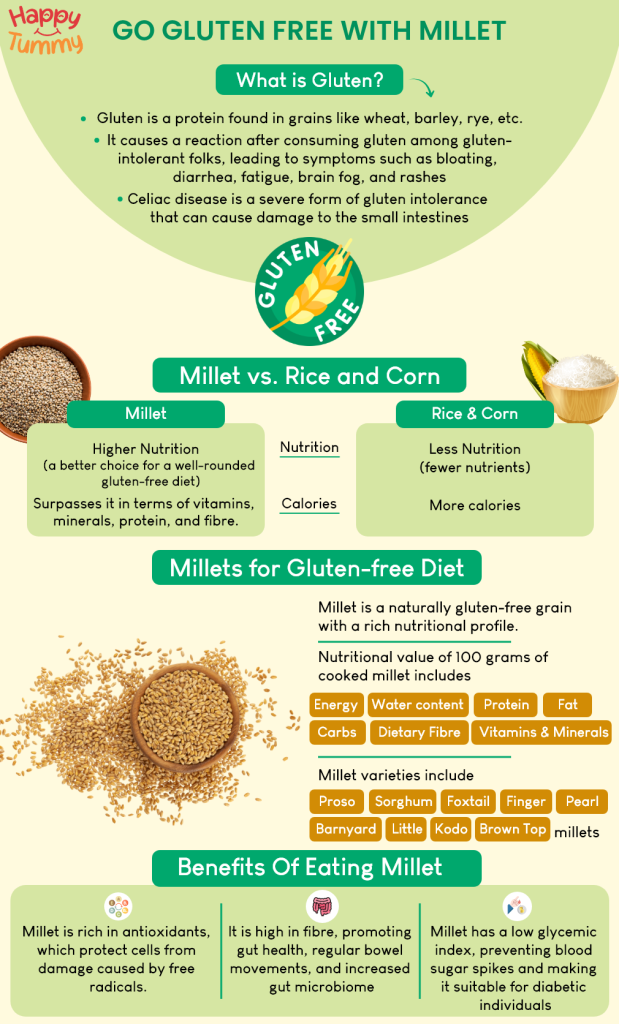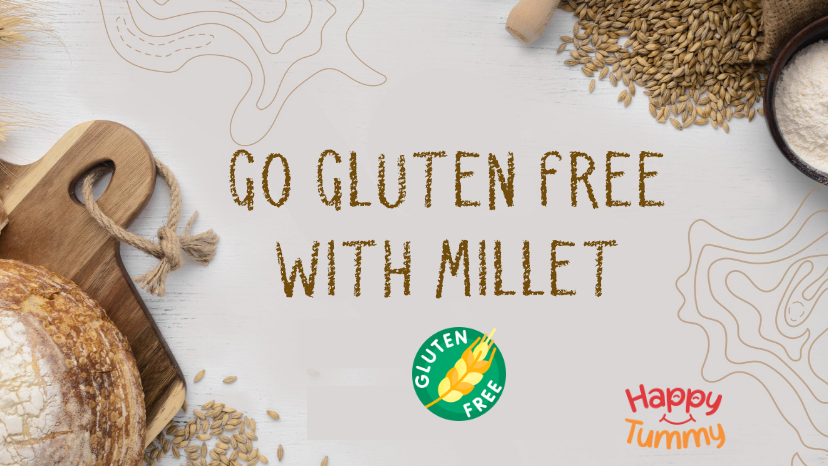Table of Contents
If you ask me, the purpose of life is to cherish the delicious food around the world.
If we breathe, it must be the aromatic biryani; if we dream, it must be risotto or sort; and if we speak, we speak of food and flavours alone.
But sometimes, this same soothing food makes us curse life. This usually happens when we suffer from gluten intolerance.
Gluten intolerance gradually instills in us, a scare of food. Pain, low energy, fatigue, rashes, mood swings, and whatnot we get whacked with. And to save ourselves from these terrible experiences, we seek gluten-free food. This often means compromising on taste and nutrition, but not with our today’s nutritious hero — millet.
So, let’s start this by understanding the core of the issue.
What is Gluten? Knowing it inside out
Protein is vital to our well-being. It is not just a go-to word for gym buffs. To ensure that we grow gracefully, get tissues repaired, hormones released, antibodies made, etc., we must consume enough protein. But protein is not a unique molecule. It has many types. And of its many types, one is gluten.
Gluten is a protein that is found in numerous grains such as wheat, barley, rye, triticale, kamut, etc. Ever observed the chewiness and elasticity in the dough? Gluten is the flexible guy behind it. Most people can digest this protein without any discomfort. However, a few people face issues the moment it is consumed.
In them, it triggers an adverse autoimmune response such as
- Bloating
- Diarrhoea
- Fatigue
- Brain fog
- Rashes and other skin issues
And out of all who suffer from gluten intolerance, a few get celiac disease in which their small intestines face damage as well. This is a brutal form of gluten intolerance. The only life-saving straw we have to hold onto in such a painful sea is a gluten-free diet.
Now, the question of millet. What role do they play in gluten intolerance? How good are these grains? And why should you include them in your diet?
Millet – the cream of a gluten-free diet

Great people always greet millets for their gluten-free diet. They smile and they embrace it. This romance is a sweet one. And we’ll tell you why.
Let’s first start with the misconception that a gluten-free diet is not nutritious.
Indeed, when you go gluten-free, your choices come down. As a result, you have fewer options to fulfill your nutrition needs. So, with saddened eyes, you go for options such as rice, corn, etc.
Now, these are good crops, but not great crops. These grains lack a rich nutrition profile. And you fail to fulfill your nutrition requirement. But this will not be the case once you have learned about millets.
Millet is a crop that is naturally gluten-free. Not just gluten-free, but it is nutrition dense as well. Here is what you get from eating 100 grams of cooked millet.
Millet – Nutritional Value – 100 grams
| Energy | 119 kcal |
| Water content | 71.4 grams |
| Protein | 3.51 grams |
| Fat | 1 gram |
| Carbs | 23.7 grams |
| Dietary Fibre | 1.3 grams |
| Minerals | Calcium, Iron, Magnesium, Phosphorous, Potassium, Sodium, Zinc, Copper, Manganese, Selenium |
| Vitamins | Vitamin B, Folate, Choline, Carotene, Vitamin A, Vitamin K, Lutein, Zeaxanthin, Thiamine, Riboflavin, Niacin, etc. |
This is the case with Proso millet. There are other millet types as well.
Another excellent thing — you have varieties to choose from. Got fed up with Proso?
Pick Sorghum. Not your taste?
Pick Kodo. Now, here are all many types of millet that may choose from:
- Pearl millet (Bajra)
- Sorghum (Jowar)
- Finger millet (Ragi)
- Foxtail millet (Kangni)
- Proso millet (Barri)
- Barnyard millet (Sanwa)
- Little millet (Kutki)
- Kodo millet (Kodra)
- Brown Top millet (Makra)
Generally, when you eat rice or corn, you don’t get such a level of nutrition. There are calories indeed, but the nutrition is comparatively less. So, the first reason millet should be your top choice for a gluten-free diet is its higher nutrition.
1. Millet has the higher nutrition than rice
Let’s first talk about rice. 100 grams of cooked rice provides you with nearly 130 calories. This is a bit higher than 100 grams of cooked millet, which provides 119 kcal. However, when it comes to vitamins, minerals, protein, and fibre, rice doesn’t stand a chance. [1]
Apart from calcium, manganese, and selenium, it has lower amounts of micronutrients than millet. These micronutrients (vitamins and minerals) are vital to our well-being and happiness. The case stands the same with corn too. [2]
When compared with corn, millet provides more energy. 100 grams of boiled sweet corn provide anywhere around 96 calories. Also, it has many nutrients such as iron, magnesium, phosphorous, potassium, zinc, etc., in amounts lower than those of millet. But this doesn’t mean you should leave corn, maize, or other delicacy. The wisdom lies in the balance.
Your diet must be a diverse one. It must not have too much of one thing. This same stands still in the case of millet too. Millet, although nutritious, should not be solely depended upon. Try to keep a healthy and friendly ratio that includes all the grains.
2. Millet is rich in antioxidants
Antioxidants, antioxidants, and antioxidants. Too much buzz around, yes? Well, it is for all the good reasons. Although these molecules are not a nostrum for all your ails, these indeed are must-have ones.
Antioxidants help us age gracefully. Without a hitch. These gentlemen protect our cells from damage done by free radicals. And when they are done protecting, they also move forward to strengthen our immunities. Brilliant right? Well, a bit more brilliance left still. Antioxidants have also been found helpful for skin health, heart health, eye health, and overall well-being. Now, know that millet is a crop profuse of antioxidants as well. [3]
3. Has a high fibre and low glycaemic index
Fibre is that character in our healthy movie who plays an underdog. It is often overlooked. But now, the spotlight is shifting over its hat. Fibre is important because it cleanses our guts, promotes regular bowel movements, and increases the gut microbiome (the good gut bacteria). All these things enhance digestion. And when digestion wears a smile, life becomes easier.
Millet has a high amount of fibre when speaking about gluten-free options. The number is over times higher than that of rice. This makes it a gut-friendly grain.
Apart from fibre, millet also has a lower glycaemic index, which means that it behaves gently on blood sugar levels. When you eat it, your blood sugar doesn’t peak quickly as happens in the case of rice. This is the reason rice is generally not recommended for diabetic people. So, eat millet and fly like a willet. And when you fly, smile about the fact that you’ve eaten a diet that is light and healthy for your heart too. A diet that keeps cholesterol levels under check due to its omega-3 and omega-6 fatty acids content.
Always stay properly hydrated, especially when consuming grains like millet. Aim for at least 2 litres of water if you are not physically active.
4. Can be cooked in many delicious ways
The issue with a gluten-free diet is that one has fewer options, which means repetitiveness entering your kitchen. Too boring. But not when you have tiny yet mighty millet in your kitchen jars.
First of all, you don’t have only one crop in your kitchen. Millet offers varieties such as Kodo, Proso, Barnyard, Sorghum, etc. This means increased options.
Then, you can use these grains in a variety of ways to spice up your life. If someone says again that you don’t have enough dishes to choose from, send a tiny grain of millet flying toward their forehead.
Now, want to know what can you cook? Head on to the next section.
What can you cook using millet?
Millet is a gem of food. You can soak it and turn it into a salad. You can pop it into popcorn and enjoy your favourite show. And if it is about lunch, you can boil it, fry it, crush it, and whatnot else apart. However, deep frying is not recommended when it comes to health.
So, here are some of the ways, some top millet recipes, that you can use millet to enhance your gastronomic life:
- Spicy Millet Pops: These millet pops are made the same way popcorn is made. The millet used in this is sorghum, which is nutritious and delicious.
- Millet Pulao: Replace your regular pulao with steaming millet pulao assorted with veggies and exotic Indian spices.
- Ragi Dosa: Can’t enter the noon without having a dosa in the morning? Well, have a healthier option made with Ragi, the fancy finger millet.
- Zan – Finger Millet Veggie Porridge: An Arunachali delicacy that uses sprouted millet flour cooked with spinach, spices, soybeans, and other vegetables.
- Coco-Ragi Cook: Bakeries are not bad, especially when made with sprouted ragi flour. These cookies are sure to add a sweet crisp to your day.
- Lemony Millets: Love lemon? Then why not use it to flavour your millet?
- Ragi Laddoos: Another sweet pick to add some soothing flavours to your life. Made with jaggery and millet flour, these laddoos are something that never hears a ‘no’. And if you need the easiest way to cook millet
And if you want the easiest way to eat millet, use the Aashirvaad Multi-Millet Mix to make your recipes like Dosa, millet chappati, cookies, cakes, and so much more
Also Read – Top Millet Recipes to try at home
Conclusion
Gluten intolerance is an insidious ghost that is not there and yet is there. It never lets a few of us enjoy the many delicacies adorning the dinner table. This often means being unable to meet the nutrition requirement in our daily lives. But with millet, most of these issues are taken care of.
Millet is an excellent choice for all, no matter if you are gluten intolerant or not. But the biggest benefit of millet comes for those who cannot digest the gluten present in foods. Millet not only is gluten-free, but its many varieties out there add numerous flavours to life as well. And above it all, you get that missing dose of vitamins and minerals. Being rich in calcium, iron, magnesium, phosphorous, vitamins B, A, folate, etc., this shapes our lives towards health and happiness. We’ve even given you a hack to go gluten-free with Aashirvaad Multi-Millet mix. Just make sure that you drink enough water to counter its drying effect.
So, make a few changes to your diet and add millet to your menu as well. This gluten-free grain is so healthy, it’s practically a superhero. Just don’t tell the Avengers about it, they might get jealous. Give Millet a try today!
All millets are naturally gluten-free, making them suitable for individuals with gluten intolerance or celiac disease.
By consuming millet regularly, you can promote weight management, enhance digestion, regulate blood sugar levels, support cardiovascular health, strengthen your immune system, and experience sustained energy levels throughout the day.
Traditional wheat chapatis contain gluten. However, there are gluten-free alternatives available that can be used to make chapatis. You can instead use millets for gluten-free chapati.
Several flours are naturally gluten-free and can be used as alternatives to wheat flour. Some common gluten-free flours include:
Rice flour
Aashivaad multi-millet mix flour (a mix of jowar, bajra, ragi, navane and Quinoa, etc.)
Almond flour
Coconut flour
Tapioca flour (also known as tapioca starch)
Buckwheat flour
Sorghum flour
Chickpea flour (besan)
Quinoa flour















